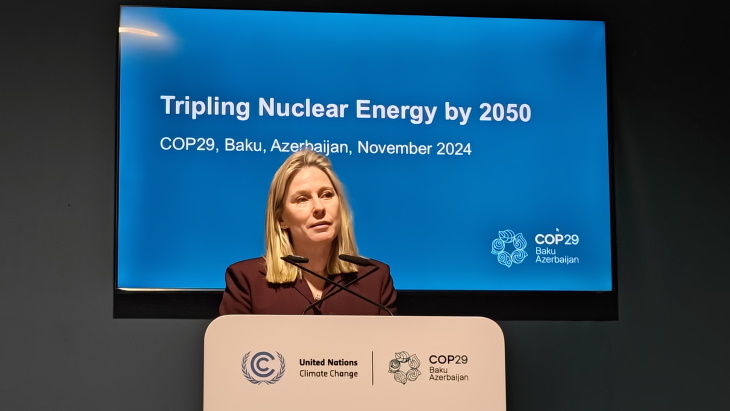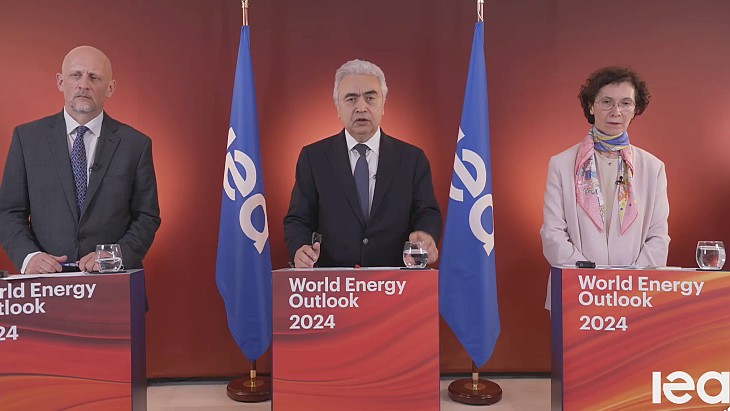A low-carbon future needs partnerships
.jpg)
That future will not be achieved if the nuclear power and renewable energy industries continue to compete as solutions to climate change, rather than work together with a common goal, delegates said. Participation in the conference by the International Renewable Energy Agency (IRENA) was, therefore, a welcome sign of progress.
Internal links
Luca Angelino, a programme officer with IRENA's country support and partnerships division, and Wei Huang, director of energy planning, information and knowledge management in the IAEA's Department of Nuclear Energy, each presented ways their respective organisations are working to build partnerships.
Angelino described, for example, the Global Geothermal Alliance and the IRENA Coalition for Action. Huang said the IAEA had been able to forge links with other agencies of the UN, such as the United Nations Department of Economic and Social Affairs, in developing its climate change and sustainability agenda, particularly through its work on the non-electricity applications of nuclear energy, for instance in healthcare.
A member of the audience asked whether the IAEA and IRENA could form an alliance to present a united front on the climate emergency. Neither could give a commitment to this, as it lies outside the mandates of their respective organisations, Huang said. He highlighted however, a report that the IAEA had published last year - Nuclear-Renewable Hybrid Energy Systems for Decarbonised Energy Production and Cogeneration - which demonstrates its efforts to find a combined low-carbon energy solution.
It is a technical report, he said, rather than a strategy, which would require a policy decision at the IAEA's governing level. Referring to the conference, the agency's first on climate change, he added: "We have offered this platform to have the Member States sit together to discuss this possibility, but we follow instructions from our policy organs."
Angelino stressed that the renewable energy industry is not uniform, but includes technologies that each have their own attributes and challenges, and often compete with each other for recognition and investment.
"People tend to use the word 'renewables' as a synonym," he said, "but we are talking about a variety of technologies that are very diverse." The Coalition for Action has been an opportunity for developers of different technologies - hydro, wind, solar PV and geothermal - to find common ground for collaboration, he added.
Climate policy
Huang said that IAEA conferences are normally attended by representatives of the nuclear and energy sectors, but that the global issue of climate change is often led by environmental groups. "At the IAEA, as an intergovernmental organisation, there are ongoing efforts with our partners to encourage their ministries of the environment, and other organisations leading this global issue, to come to our conferences to learn more about the potential of nuclear power."
Florin Vladu, a programme officer in the secretariat of the United Nations Framework Convention on Climate Change, spoke of how nuclear power could apply to sections of the Paris Agreement. Guidance on the framework on Article 6, which offers Parties the opportunity to cooperate with one another by using mitigation mechanisms, is still under negotiation and there is an argument for the role of nuclear power in this, he said.
"We've heard about the possible contribution of nuclear power to Article 6 and of course decarbonisation and [its] contribution to reducing temperature growth, which is part of Article 2. We can also see a role for discussing nuclear power under 'technology and finance' as well as 'capacity building'," he said. "When you talk about the transition to a low-carbon economy, nuclear power has a role," he said, and this also applies to sustainable socio-economic development.
Collaboration
Suzie Jaworowski, senior advisor in the Office of Nuclear Energy at the US Department of Energy, highlighted the US Administration's support for nuclear power. At the 8th Clean Energy Ministerial (CEM8), held in Beijing in 2017, US Secretary of Energy Rick Perry had noticed the absence of nuclear power from the agenda. A direct result of his observation, Jaworowski said, was the launch of the multi-governmental Nuclear Innovation: Clean Energy Future (NICE Future) initiative at CEM9 in Copenhagen in May 2018. This initiative has firmly placed nuclear energy in ministerial-level discussions on clean energy, she said.
"The NICE Future initiative was started by three lead countries, the United States, Canada and Japan, which came together with the understanding that it's really important to be able to demonstrate the way renewables and nuclear can work together," she said. It now has nine signatory countries and 14 non-governmental organisations, and she invited delegates to encourage more countries to join.
Jonathan Cobb, senior communications manager at World Nuclear Association, explained how the nuclear industry's Harmony programme provides a clear starting point for partnerships. The Harmony goal - for nuclear to have a 25% share of the global electricity market by 2050, by adding 1000 GWe of new capacity - gives the Association's 180 members a focus for collaboration, he said.
Regarding cooperation between clean energy industries, he said, "Often different forms of energy are pitted against each other, sometimes by national policy, and so it can be hard to form alliances. The focus needs to be on the areas where partnerships with associations of different forms of low-carbon energy can provide mutual benefit, where their combined influence on issues of climate policy would be better than if they were acting individually."
Different approaches
As in the renewable energy sector, so too in nuclear there are various proposals for its role in the clean energy transition.
Kirsten Gogan, executive director of Energy for Humanity, described the Flexible Nuclear Campaign, which she said is one of the first times that advanced nuclear technology will be included in large-scale energy modelling. It is based on the premise that combining wind and solar with nuclear power generation supports a resilient energy system at reasonable cost. Designs that are coming online in the 2020s to 2030s, such as small modular reactors, can offer improved flexibility to deliver energy in grids with high renewables penetration, she said.
She referred to discussions around the hydrogen economy, which are often limited to two options - electrolysis using variable renewables, and steam methane reform with carbon capture and storage - and overlook the third option of using nuclear technology for high-temperature heat electrolysis.
"It is absent from the discourse, but deserves to be considered alongside the other options," she said, "because there is real potential to achieve very cost-competitive hydrogen production and synfuels production, for use in shipping, aviation and other really hard-to-decarbonise sectors, at scale."
Staffan Qvist, director of Qvist Consulting, described how countries with large-scale nuclear, with some contribution from renewable energy, are consistently 'green' 24/7. He proved this to delegates using electricitymap.org, which shows the climate impact of electricity hour-by-hour.
His company's study on the Swedish electricity system - which has long-established nuclear and hydropower generation - concludes that system costs are always lower with the long-term operation of existing nuclear reactors. They are lower with new reactors in the mix if, firstly, strict emissions targets are set which limits natural gas and, secondly, interconnectors are realistically modelled, he said. With the system cost argument established, he said, there then needs to be a market design that allows low-carbon electricity producers a return on investments, and policies to lower the weighted average cost of capital in new nuclear projects.
"We need to figure out how to design the markets to make the lowest-cost system come to life," he said, adding that an effective potential example of this may be the UK's proposed regulated asset base model.

_99697.jpg)








_50521.jpg)

